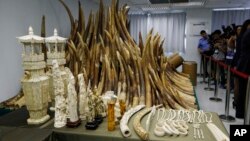GENEVA —
A major wildlife conservation group reports more than 20,000 African elephants were poached across the African continent last year. CITES, the Convention on International Trade in Endangered Species of Wild Fauna and Flora, warns that poaching contributes to the continuing decline in elephant populations.
According to CITES, 2013 was the third year in a row more than 20,000 elephants have been killed across the African continent. It says the sharp upward trend in illegal elephant killing observed since the mid-2000s peaked in 2011 and is leveling off.
But, CITES Secretary-General, John Scanlon, says poaching levels remain alarmingly high. He says Africa’s elephants continue to face an immediate threat to their survival from high levels of poaching for their ivory.
“We are still seeing the elephant populations in decline, which means that the levels of illegal killing are exceeding the natural birthrates. But, overall, the population of the African elephant is in decline. However…the upward trends we saw that became very sharp in 2010 and 2011 in terms of the levels of illegal killing have started to level off. But, at a level that is far too high; namely we still have over 20,000 African elephants killed per year." said Scanlon.
The CITES report shows an increase in the number of large seizures of ivory made in 2013. For the first time, the conservation group says more smuggled ivory was seized in Africa than in Asia, where the market for the illegal product is huge.
It says three African countries - Kenya, Tanzania and Uganda - account for 80 percent of those seizures. Scanlon says the large scale of the ivory seizures indicate transnational organized crime and rebel militia are involved in the illicit ivory trade. He says this demands a stronger, more concerted response from the international community.
“This is a serious crime. It needs to be treated as a serious crime and we need to deploy the same sorts of techniques that are used to combat other serious crimes, such as illicit trade in narcotics or human trafficking or illicit trade in arms," he said. "At one point of time, a seizure was seen as a success under CITES. What we are saying is a seizure is not a success. It is important. It is a critical part of the process. You have to go beyond the seizure. And you have to go beyond the seizure to find actually who is at the end of that, who wanted that in the first place? Who ordered that? How do you catch them? "
CITES monitors 51 sites across Africa to keep tabs on illegal killing of elephants. It finds the greatest increase in poaching was in Dzanga Sangha in Central African Republic. On the other hand, it says poaching levels decreased substantially in parks in Chad, Zimbabwe and Uganda.
According to CITES, 2013 was the third year in a row more than 20,000 elephants have been killed across the African continent. It says the sharp upward trend in illegal elephant killing observed since the mid-2000s peaked in 2011 and is leveling off.
But, CITES Secretary-General, John Scanlon, says poaching levels remain alarmingly high. He says Africa’s elephants continue to face an immediate threat to their survival from high levels of poaching for their ivory.
“We are still seeing the elephant populations in decline, which means that the levels of illegal killing are exceeding the natural birthrates. But, overall, the population of the African elephant is in decline. However…the upward trends we saw that became very sharp in 2010 and 2011 in terms of the levels of illegal killing have started to level off. But, at a level that is far too high; namely we still have over 20,000 African elephants killed per year." said Scanlon.
The CITES report shows an increase in the number of large seizures of ivory made in 2013. For the first time, the conservation group says more smuggled ivory was seized in Africa than in Asia, where the market for the illegal product is huge.
It says three African countries - Kenya, Tanzania and Uganda - account for 80 percent of those seizures. Scanlon says the large scale of the ivory seizures indicate transnational organized crime and rebel militia are involved in the illicit ivory trade. He says this demands a stronger, more concerted response from the international community.
“This is a serious crime. It needs to be treated as a serious crime and we need to deploy the same sorts of techniques that are used to combat other serious crimes, such as illicit trade in narcotics or human trafficking or illicit trade in arms," he said. "At one point of time, a seizure was seen as a success under CITES. What we are saying is a seizure is not a success. It is important. It is a critical part of the process. You have to go beyond the seizure. And you have to go beyond the seizure to find actually who is at the end of that, who wanted that in the first place? Who ordered that? How do you catch them? "
CITES monitors 51 sites across Africa to keep tabs on illegal killing of elephants. It finds the greatest increase in poaching was in Dzanga Sangha in Central African Republic. On the other hand, it says poaching levels decreased substantially in parks in Chad, Zimbabwe and Uganda.








